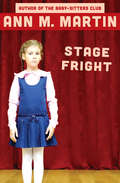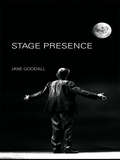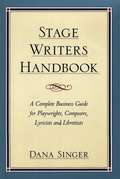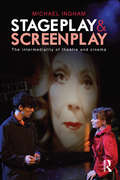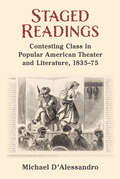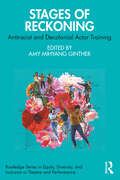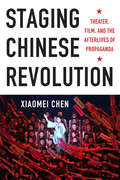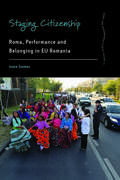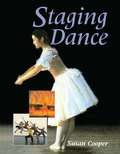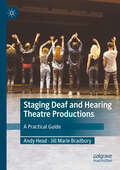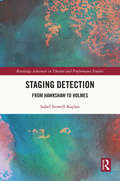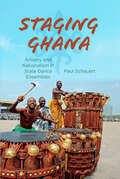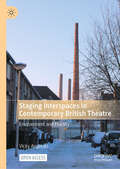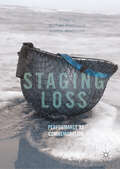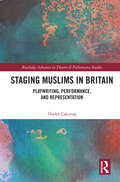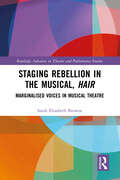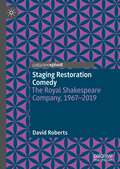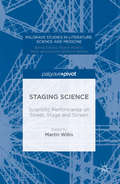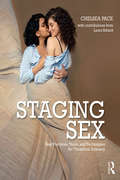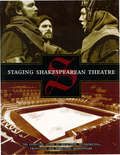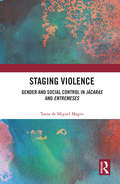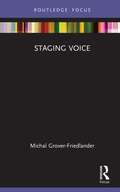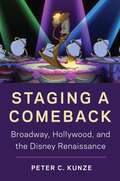- Table View
- List View
Stage Fright: Its Role In Acting
by Ann M. MartinCan Sara overcome her shyness to perform in the school play? Sara is extremely timid—she only has two friends, and one of them is her cousin. Her mother is constantly pushing her to leave the safety of her room and be more social, but for Sara, being in public is a punishment worse than death.When Sara&’s teacher insists that everyone this year—shy or not—participate in the school play, Sara is filled with terror. To top it off, she finds out her best friend, the one person who understands her, might be moving away. More than ever, Sara wants to climb into her shell, but the play is looming and there&’s no place to hide.This ebook features an illustrated personal history of Ann M. Martin, including rare images from the author&’s collection.
Stage Presence
by Jane GoodallFocusing on examples of live performance in drama, dance, opera and light entertainment, Jane Goodall explores a characteristic as compelling and enigmatic as the performers who demonstrate it. The mysterious quality of ‘presence’ in a performer has strong resonances with the uncanny. It is associated with primal, animal qualities in human individuals, but also has connotations of divinity and the supernatural, relating to figures of evil as well as heroism. Stage Presence traces these themes through theatrical history. This fascinating study also explores the blend of science and spirituality that accompanies the appreciation of human power. Performers display a magnetism of their audiences; they electrify them, exhibit mesmeric command, and develop chemistry in their communication. Case studies include: Josephine Baker, Sarah Bernhardt, Thomas Betterton, David Bowie, Maria Callas, Bob Dylan, David Garrick, Barry Humphries, Henry Irving, Vaslav Nijinsky and Paul Robeson.
Stage Writers Handbook
by Dana SingerDana Singer, Associate Director of America's foremost playwrights' association, the Dramatists Guild, gathers all the information and ideas stage writers need to conduct their careers in a businesslike manner, with all the protections the law provides. Includes chapters devoted to copyright, self-promotion, representation, production contracts, publishing and licensing agreements, underlying rights and collaboration.
Stage-Play and Screen-Play: The intermediality of theatre and cinema
by Michael InghamDialogue between film and theatre studies is frequently hampered by the lack of a shared vocabulary. Stage-Play and Screen-Play sets out to remedy this, mapping out an intermedial space in which both film and theatre might be examined. Each chapter’s evaluation of the processes and products of stage-to-screen and screen-to-stage transfer is grounded in relevant, applied contexts. Michael Ingham draws upon the growing field of adaptation studies to present case studies ranging from Martin McDonagh’s The Cripple of Inishmaan and RSC Live’s simulcast of Richard II to F.W. Murnau’s silent Tartüff, Peter Bogdanovich’s film adaptation of Michael Frayn’s Noises Off, and Akiro Kurosawa’s Ran, highlighting the multiple interfaces between media. Offering a fresh insight into the ways in which film and theatre communicate dramatic performances, this volume is a must-read for students and scholars of stage and screen.
Staged Readings: Contesting Class in Popular American Theater and Literature, 1835-75
by Michael D'AlessandroStaged Readings studies the social consequences of 19th-century America’s two most prevalent leisure forms: theater and popular literature. In the midst of watershed historical developments—including numerous waves of immigration, two financial Panics, increasing wealth disparities, and the Civil War—American theater and literature were developing at unprecedented rates. Playhouses became crowded with new spectators, best-selling novels flew off the shelves, and, all the while, distinct social classes began to emerge. While the middle and upper classes were espousing conservative literary tastes and attending family matinees and operas, laborers were reading dime novels and watching downtown spectacle melodramas like Nymphs of the Red Sea and The Pirate’s Signal or, The Bridge of Death!!! As audiences traveled from the reading parlor to the playhouse (and back again), they accumulated a vital sense of social place in the new nation. In other words, culture made class in 19th-century America. Based in the historical archive, Staged Readings presents a panoramic display of mid-century leisure and entertainment. It examines best-selling novels, such as Harriet Beecher Stowe’s Uncle Tom’s Cabin and George Lippard’s The Quaker City. But it also analyzes a series of sensational melodramas, parlor theatricals, doomsday speeches, tableaux vivant displays, curiosity museum exhibits, and fake volcano explosions. These oft-overlooked spectacles capitalized on consumers’ previous cultural encounters and directed their social identifications. The book will be particularly appealing to those interested in histories of popular theater, literature and reading, social class, and mass culture.
Stages of Reality
by Jeremy Maron André LoiselleA groundbreaking collection of original essays, Stages of Reality establishes a new paradigm for understanding the relationship between stage and screen media. This comprehensive volume explores the significance of theatricality within critical discourse about cinema and television.Stages of Reality connects the theory and practice of cinematic theatricality through conceptual analyses and close readings of films including The Matrix and There Will be Blood. Contributors illuminate how this mode of address disrupts expectations surrounding cinematic form and content, evaluating strategies such as ostentatious performances, formal stagings, fragmentary montages, and methods of dialogue delivery and movement. Detailing connections between cinematic artifice and topics such as politics, gender, and genre, Stages of Reality allows readers to develop a clear sense of the multiple purposes and uses of theatricality in film.
Stages of Reckoning: Antiracist and Decolonial Actor Training (Routledge Series in Equity, Diversity, and Inclusion in Theatre and Performance)
by Amy Mihyang GintherStages of Reckoning is a crucial conversation about how racialized bodies and power intersect within actor training spaces. This book provokes embodied and intellectual discomfort for the reader to take risks with their ideologies, identities, and practices and to make new pedagogical choices for students with racialized identities. Centering the voices of actor trainers of color to acknowledge their personal experience and professional pedagogy as theory, this volume illuminates actionable ideas for text work, casting, voice, consent practices, and movement while offering decolonial approaches to current Eurocentric methods. These offerings invite the reader to create spaces where students can bring more of themselves, their communities, and their stories into their training and as fodder for performance making that will lead to a more just world. This book is for people in high/secondary schools, higher education, and private training studios who wish to teach and direct actors of color in ways that more fully honor their multiple identities.
Staging Age
by Valerie Barnes Lipscomb Leni MarshallThis text explores how performers offer conscious-and unconscious-portrayals of the spectrum of age to their audiences. It considers a variety of media, including theatre, film, dance, advertising, and television, and offers critical foundations for research and course design, sound pedagogical approaches, and analyses.
Staging Chinese Revolution: Theater, Film, and the Afterlives of Propaganda
by Xiaomei ChenStaging Chinese Revolution surveys fifty years of theatrical propaganda performances in China, revealing a dynamic, commercial capacity in works often dismissed as artifacts of censorship. Spanning the 1960s through the 2010s, Xiaomei Chen reads films, plays, operas, and television shows from an interdisciplinary and comparative perspective, demonstrating how, in a socialist state with "capitalist characteristics," propaganda performance turns biographies, memoirs, and war stories into mainstream ideological commodities, legitimizing the state and its right to rule. Analyzing propaganda performance also brings contradictions and inconsistencies to light that throw common understandings about propaganda's purpose into question.Chen focuses on revisionist histories that stage the lives of the "founding fathers" of the Communist Party, such as Chen Duxiu, Mao Zedong, and Deng Xiaoping, and the engaging mix of elite and ordinary characters that animate official propaganda in the private and public sphere. Taking the form of "personal" memories and representing star and youth culture and cyberspace, contemporary Chinese propaganda appeals through multiple perspectives, complicating relations among self, subject, agent, state building, and national identity. Chen treats Chinese performance as an extended form of political theater confronting critical issues of commemoration, nostalgia, state rituals, and contested history. It is through these reenactments that three generations of revolutionary leaders loom in extraordinary ways over Chinese politics and culture.
Staging Citizenship: Roma, Performance and Belonging in EU Romania (Dance and Performance Studies #11)
by Ioana SzemanBased on over a decade of fieldwork conducted with urban Roma, Staging Citizenship offers a powerful new perspective on one of the European Union’s most marginal and disenfranchised communities. Focusing on “performance” broadly conceived, it follows members of a squatter’s settlement in Transylvania as they navigate precarious circumstances in a postsocialist state. Through accounts of music and dance performances, media representations, activism, and interactions with both non-governmental organizations and state agencies, author Ioana Szeman grounds broad themes of political economy, citizenship, resistance, and neoliberalism in her subjects’ remarkably varied lives and experiences.
Staging Dance (Ballet, Dance, Opera And Music Ser.)
by Susan CooperStaging Dance is a practical handbook that covers all aspects of putting on a dance production. It highlights the current diversity of dance activities, choosing examples from working dance groups and from individual dancers.The book includes sections on choreography, music and sound, designing and making sets and costumes, lighting design and technical implementation and stage management. Funding, planning and publicity are also covered.Staging Dance will prove invaluable not only to dance artists, but also those working along side them: musicians, designers, lighting technicians, administrators and directors.
Staging Deaf and Hearing Theatre Productions: A Practical Guide
by Andy Head Jill Marie BradburyThis book explores an unacknowledged gap in theatre study and praxis, and establishes an inceptive model for transforming a playscript into a theatrical production involving deaf and hearing artists. The book stipulates that theatrical productions of this nature should strive to go beyond accessibility towards inclusivity by considering deaf perspectives at every stage of the process: When deaf actors are cast in roles assumed to be hearing, how does this change the world of the play? How does the inclusion of a visual language affect staging decisions? How can truly equal access to two different language modalities be achieved for diverse production teams and audiences? Because deaf artists should be involved in the leadership and creative decision making throughout the process, this book is co-written by a deaf and hearing team. The main topics of the book include pre-production preparation, the rehearsal process, and performance. As deaf theatre artists move increasingly into the foreground, it’s time for the hearing theatre world to learn how to undertake productions that successfully bridge the deaf and hearing worlds. By including the perspective of directors, actors, designers, and audience members, this guide lays out an ideal process towards achieving that goal.
Staging Detection: From Hawkshaw to Holmes (Routledge Advances in Theatre & Performance Studies)
by Isabel Stowell-KaplanStaging Detection reveals how the new figure of the stage detective emerged in nineteenth-century Britain. The first book to explore the productive intersections between detection and performance across a range of Victorian plays, Staging Detection foregrounds the role of the stage detective in shaping important theatrical modes of the period, from popular melodrama to society comedy. Beginning in 1863 with Tom Taylor’s blockbuster play, The Ticket-of-Leave Man, the book criss-crosses London following the earliest performances of stage detectives. Centring the work of playwrights, novelists, critics and actors, from Sarah Lane and Horace Wigan to Wilkie Collins and Oscar Wilde, Staging Detection sheds new light on Victorian acting styles, furthers our understanding of melodrama, and resituates the famous Wildean dandy as a successor to the stage detective. Drawing on histories of masculinity and gender performance as well as developing scientific theory and nineteenth-century visual culture, Staging Detection shows how the earliest stage portrayals of the detective shaped broader Victorian debates concerning fraud, omniscience and earned authority. This book will be of great interest to students and scholars of theatre history, Victorian literature and popular culture – as well as anyone with an interest in the figure of the detective.
Staging Ghana: Artistry And Nationalism In State Dance Ensembles (Ethnomusicology Multimedia)
by Paul SchauertThe Ghana Dance Ensemble takes Ghana's national culture and interprets it in performance using authentic dance forms adapted for local or foreign audiences. Often, says Paul Schauert, the aims of the ensemble and the aims of the individual performers work in opposition. Schauert discusses the history of the dance troupe and its role in Ghana's post-independence nation-building strategy and illustrates how the nation's culture makes its way onto the stage. He argues that as dancers negotiate the terrain of what is or is not authentic, they also find ways to express their personal aspirations, discovering, within the framework of nationalism or collective identity, that there is considerable room to reform national ideals through individual virtuosity.
Staging Interspaces in Contemporary British Theatre: Environment and Fluidity
by Vicky AngelakiThis open access book considers how relationships to place and spatial ecologies more broadly are becoming redefined in light of intersecting climate, health, identity and care crises. Through an interdisciplinary, intersectional discourse it investigates how spaces of liminality frame contemporary human conditions in their interactional modes with both human and non-human ecologies. The interspace grounds the discussion, indicating states of flux and transience, where the in-between is the defining characteristic. This open access monograph, then, takes up the new complexity in one’s relationship(s) to their surrounding spaces through a rigorous discussion of texts and performance contexts in cutting-edge contemporary British theatre on a national and international scale. It seeks to address how in-betweenness spatially, temporally, environmentally, geographically and socially conceived has been emerging as the primary state for the unmoored individual of our time – and how it might serve as catalyst for performing one's agency in modes more empathetic not only to other humans, but, also, and equally, to the non-human world.
Staging Loss: Performance as Commemoration
by Andrew Westerside Michael PinchbeckThis book locates and critically theorises an emerging field of twenty-first century theatre practice concerned, either thematically, methodologically, or formally, with acts of commemoration and the commemorative. With notions of memorial, celebration, temporality and remembrance at its heart, and as a timely topic for debate, this book asks how theatre and performance intersects with commemorative acts or rituals in contemporary theatre and performance practice. It considers the (re)performance of history, commemoration as a form of, or performance of, ritual, performance as memorial, performance as eulogy and eulogy as performance. It asks where personal acts of remembrance merge with public or political acts of remembrance, where the boundary between the commemorative and the performative might lie, and how it might be blurred, broken or questioned. It explores how we might remake the past in the present, to consider not just how performance commemorates but how commemoration performs.
Staging Muslims in Britain: Playwriting, Performance, and Representation (Routledge Advances in Theatre & Performance Studies)
by Önder ÇakırtaşThis scholarly volume delves into the manner in which British Muslims articulate their cultural, social and religious identities through theatrical productions in 21st-century Britain and examines their portrayal within these performances.The study investigates the factors influencing the emergence and evolution of Islamic theatre in Britain, providing an in-depth analysis of plays by British playwrights of both Muslim and non-Muslim origins that have shaped the trajectory of British Islamic theatre from the late 20th century to the present. Önder Çakırtaş critically examines how British playwrights, predominantly of Muslim origin but also including some of non-Muslim origin, depict Muslim identity and culture from their unique perspectives, particularly in the context of post-9/11 society. Adopting a comprehensive approach to Islamic playwriting and performance, this book highlights the accomplishments and contributions of contemporary British playwrights, primarily from Muslim backgrounds.This study will be of significant interest to scholars and students in theatre studies, as well as related disciplines such as Islamic studies, sociology and political science.
Staging Rebellion in the Musical, Hair: Marginalised Voices in Musical Theatre (Routledge Advances in Theatre & Performance Studies)
by Sarah Elisabeth BrowneThis volume provides a comprehensive survey of the musical Hair and will offer critical analysis which focuses on giving voice to those who are historically considered to be on the margins of musical theatre history. Sarah Browne interrogates key scenes from the musical which will seek to identify the relationship between performance and the cultural moment. Whilst it is widely acknowledged that Hair is a product of the sixties counter-culture, this study will place the analysis in its socio-historical context to specifically reveal American values towards race, gender, and adolescence. In arguing that Hair is a rebellion against the established normative values of both American society and the art form of the musical itself, this book will suggest ways in which Hair can be considered utopian: not only as a utopian ‘text’ but in the practices and values it embodies, and the emotions it generates in its audiences. This book will be of great interest to scholars and students of music, musical theatre, popular music, American studies, film studies, gender studies, or African American studies.
Staging Restoration Comedy: The Royal Shakespeare Company, 1967-2019
by David RobertsSince its 1967 production of Vanbrugh’s The Relapse, the Royal Shakespeare Company has been the world’s leading producer of Restoration Comedies. This book is the first to document and critique the company’s history of engagement with that repertoire. It reviews the spaces in which productions have been performed, design principles, casting, voicing, textual adaptation, musical direction, actor perspectives, and the problems of how to confront, adopt or depart from received notions of Restoration style. It goes on to posit that, for all the RSC’s explorations of Restoration Comedy, the company has maintained the repertoire as a fringe interest played out in niche spaces, while recycling many of the assumptions it claims to challenge, and that what is needed is the writer-led intervention seen in RSC and National Theatre adaptations of French drama from the same period. Only then can Restoration Comedy begin to engage wider audiences in new sites of political, historical andcultural meaning.
Staging Science
by Martin WillisThis book considers scientific performances across two centuries, from the early nineteenth century to the present day. Performances include demonstrations of technologies, experiments that look like theatre, theatre that looks like science, tourist representations and natural history film-making. Its key aim is to open debate on how scientific activity, both historical and contemporary, might be understood in the context of performance studies and the imaginative acts required to stage engaging performances. Scientific performances have become increasingly of interest to historians of science, literature and science scholars, and in the field of science studies. As yet, however, no work has sought to examine a range of scientific performances with the aim of interrogating and illuminating the kinds of critical and theoretical practices that might be employed to engage with them. With scientific performance likely to become ever more central to scholarly study in the next few years this volume offer a timely, and early, intervention in the existing debates, and aims, too, to be a touchstone for future work.
Staging Sex: Best Practices, Tools, and Techniques for Theatrical Intimacy
by Chelsea PaceStaging Sex lays out a comprehensive, practical solution for staging intimacy, nudity, and sexual violence. This book takes theatre practitioners step-by-step through the best practices, tools, and techniques for crafting effective theatrical intimacy. After an overview of the challenges directors face when staging theatrical intimacy, Staging Sex offers practical solutions and exercises, provides a system for establishing and discussing boundaries, and suggests efficient and effective language for staging intimacy and sexual violence. It also addresses production and classroom specific concerns and provides guidance for creating a culture of consent in any company or department. Written for directors, choreographers, movement coaches, stage managers, production managers, professional actors, and students of acting courses, Staging Sex is an essential tool for theatre practitioners who encounter theatrical intimacy or instructional touch, whether in rehearsal or in the classroom.
Staging Shakespearean Theatre: The Essential Guide to Selecting, Interpreting, Producing and Directing Shakespe are
by Elaine NovakFrom auditions and rehearsals to publicity, this guide leads even inexperienced directors, producers, choreographers and actors through the complicated and sometimes fearsome task of staking Shakespeare. Comprehensive information is presented in a browsable format including historical background of the Elizabeth period, descriptions of major plays, a glossary of terms, suggestions for modern interpretations, step-by-step instruction for choreographing fight scenes, and a full treatment of Romeo & Juliet
Staging Violence: Gender and Social Control in Jácaras and Entremeses
by Tania de Miguel MagroStaging Violence explores gender violence in Spanish early modern short theater. This book deals with domestic violence against women, extortion of prostitutes, and violence against men who display non-conventional forms of masculinity. The author argues that many "jácaras" and "entremeses" stage subversive discourses that repudiate or complicate official narratives of gender and the use of violence as a tool for achieving gender compliance. Short comic pieces are read against comedias. Each section of the book is expertly contextualized through an overview of the legal and moral contexts and the analysis of a variety of primary sources (law codes, manuals of conduct, church rulings, transcripts of civil and religious trials, and medical manuals) as well as statistical information. Staging Violence invites the reader to consider the transgressive potential of performance. As the first monograph entirely dedicated to the study of gender in this genre, this book is a vital resource for students and scholars interested in gender studies and theatre.
Staging Voice (Routledge Voice Studies)
by Michal Grover-FriedlanderStaging Voice is a unique approach to the aesthetics of voice and its staging in performance. This study reflects on what it would mean to take opera’s decisive attribute—voice—as the foundation of its staged performance. The book thinks of staging through the medium of voice. It is a nuances exploration, which brings together scholarly and directorial interpretations, and engages in detail with less frequently performed works of major and influential 20th-century artists—Erik Satie, Bertolt Brecht and Kurt Weill—as well as exposes readers to an innovative experimental work of Evelyn Ficarra and Valerie Whittington. The study is intertwined throughout with the author’s staging of the works accessible online. This book will be of great interest to students and scholars in voice studies, opera, music theatre, musicology, directing, performance studies, practice-based research, theatre, visual art, stage design, and cultural studies.
Staging a Comeback: Broadway, Hollywood, and the Disney Renaissance
by Peter C. KunzeIn the early 1980s, Walt Disney Productions was struggling, largely bolstered by the success of its theme parks. Within fifteen years, however, it had become one of the most powerful entertainment conglomerates in the world. Staging a Comeback: Broadway, Hollywood, and the Disney Renaissance argues that far from an executive feat, this impressive turnaround was accomplished in no small part by the storytellers recruited during this period. Drawing from archival research, interviews, and textual analysis, Peter C. Kunze examines how the hiring of theatrically trained talent into managerial and production positions reorganized the lagging animation division and revitalized its output. By Aladdin, it was clear that animation—not live action—was the center of a veritable “renaissance” at Disney, and the animated musicals driving this revival laid the groundwork for the company’s growth into Broadway theatrical production. The Disney Renaissance not only reinvigorated the Walt Disney Company but both reflects and influenced changes in Broadway and Hollywood more broadly.
